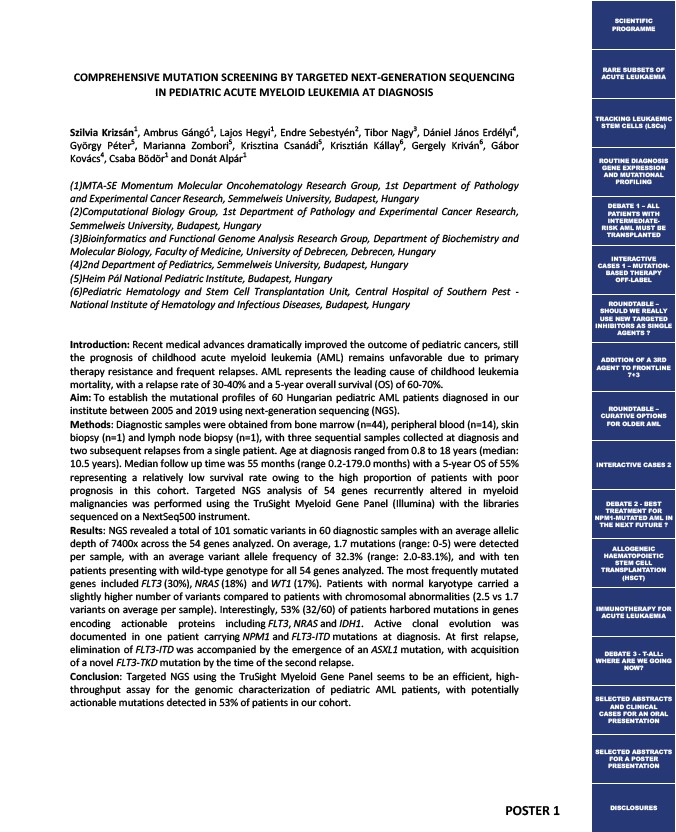
COMPREHENSIVE MUTATION SCREENING BY TARGETED NEXT-GENERATION SEQUENCING
POSTER 1
IN PEDIATRIC ACUTE MYELOID LEUKEMIA AT DIAGNOSIS
Szilvia Krizsán1, Ambrus Gángó1, Lajos Hegyi1, Endre Sebestyén2, Tibor Nagy3, Dániel János Erdélyi4,
György Péter5, Marianna Zombori5, Krisztina Csanádi5, Krisztián Kállay6, Gergely Kriván6, Gábor
Kovács4, Csaba Bödör1 and Donát Alpár1
(1)MTA-SE Momentum Molecular Oncohematology Research Group, 1st Department of Pathology
and Experimental Cancer Research, Semmelweis University, Budapest, Hungary
(2)Computational Biology Group, 1st Department of Pathology and Experimental Cancer Research,
Semmelweis University, Budapest, Hungary
(3)Bioinformatics and Functional Genome Analysis Research Group, Department of Biochemistry and
Molecular Biology, Faculty of Medicine, University of Debrecen, Debrecen, Hungary
(4)2nd Department of Pediatrics, Semmelweis University, Budapest, Hungary
(5)Heim Pál National Pediatric Institute, Budapest, Hungary
(6)Pediatric Hematology and Stem Cell Transplantation Unit, Central Hospital of Southern Pest -
National Institute of Hematology and Infectious Diseases, Budapest, Hungary
Introduction: Recent medical advances dramatically improved the outcome of pediatric cancers, still
the prognosis of childhood acute myeloid leukemia (AML) remains unfavorable due to primary
therapy resistance and frequent relapses. AML represents the leading cause of childhood leukemia
mortality, with a relapse rate of 30-40% and a 5-year overall survival (OS) of 60-70%.
Aim: To establish the mutational profiles of 60 Hungarian pediatric AML patients diagnosed in our
institute between 2005 and 2019 using next-generation sequencing (NGS).
Methods: Diagnostic samples were obtained from bone marrow (n=44), peripheral blood (n=14), skin
biopsy (n=1) and lymph node biopsy (n=1), with three sequential samples collected at diagnosis and
two subsequent relapses from a single patient. Age at diagnosis ranged from 0.8 to 18 years (median:
10.5 years). Median follow up time was 55 months (range 0.2-179.0 months) with a 5-year OS of 55%
representing a relatively low survival rate owing to the high proportion of patients with poor
prognosis in this cohort. Targeted NGS analysis of 54 genes recurrently altered in myeloid
malignancies was performed using the TruSight Myeloid Gene Panel (Illumina) with the libraries
sequenced on a NextSeq500 instrument.
Results: NGS revealed a total of 101 somatic variants in 60 diagnostic samples with an average allelic
depth of 7400x across the 54 genes analyzed. On average, 1.7 mutations (range: 0-5) were detected
per sample, with an average variant allele frequency of 32.3% (range: 2.0-83.1%), and with ten
patients presenting with wild-type genotype for all 54 genes analyzed. The most frequently mutated
genes included FLT3 (30%), NRAS (18%) and WT1 (17%). Patients with normal karyotype carried a
slightly higher number of variants compared to patients with chromosomal abnormalities (2.5 vs 1.7
variants on average per sample). Interestingly, 53% (32/60) of patients harbored mutations in genes
encoding actionable proteins including FLT3, NRAS and IDH1. Active clonal evolution was
documented in one patient carrying NPM1 and FLT3-ITD mutations at diagnosis. At first relapse,
elimination of FLT3-ITD was accompanied by the emergence of an ASXL1 mutation, with acquisition
of a novel FLT3-TKD mutation by the time of the second relapse.
Conclusion: Targeted NGS using the TruSight Myeloid Gene Panel seems to be an efficient, high-throughput
assay for the genomic characterization of pediatric AML patients, with potentially
actionable mutations detected in 53% of patients in our cohort.
SCIENTIFIC
PROGRAMME
RARE SUBSETS OF
ACUTE LEUKAEMIA
TRACKING LEUKAEMIC
STEM CELLS (LSCs)
ROUTINE DIAGNOSIS
GENE EXPRESSION
AND MUTATIONAL
PROFILING
DEBATE 1 – ALL
PATIENTS WITH
INTERMEDIATE-RISK
AML MUST BE
TRANSPLANTED
INTERACTIVE
CASES 1 – MUTATION-BASED
THERAPY
OFF-LABEL
ROUNDTABLE –
SHOULD WE REALLY
USE NEW TARGETED
INHIBITORS AS SINGLE
AGENTS ?
ADDITION OF A 3RD
AGENT TO FRONTLINE
7+3
ROUNDTABLE –
CURATIVE OPTIONS
FOR OLDER AML
INTERACTIVE CASES 2
DEBATE 2 - BEST
TREATMENT FOR
NPM1-MUTATED AML IN
THE NEXT FUTURE ?
ALLOGENEIC
HAEMATOPOIETIC
STEM CELL
TRANSPLANTATION
(HSCT)
IMMUNOTHERAPY FOR
ACUTE LEUKAEMIA
DEBATE 3 - T-ALL:
WHERE ARE WE GOING
NOW?
SELECTED ABSTRACTS
AND CLINICAL
CASES FOR AN ORAL
PRESENTATION
SELECTED ABSTRACTS
FOR A POSTER
PRESENTATION
DISCLOSURES